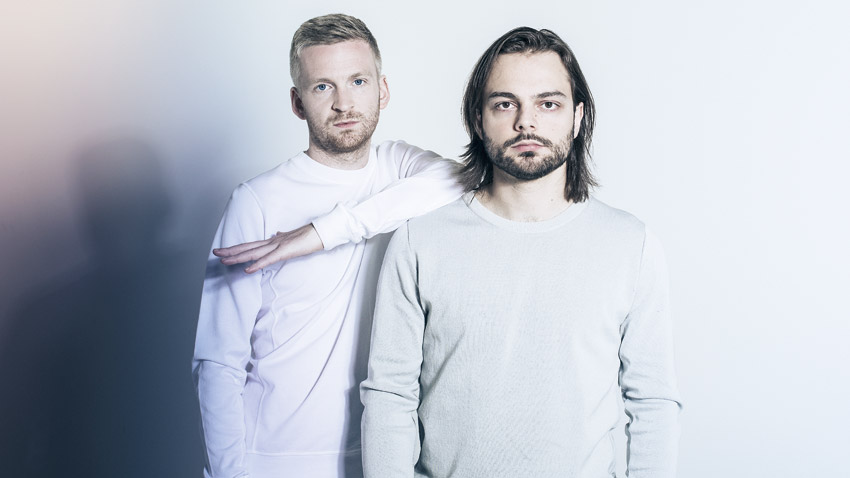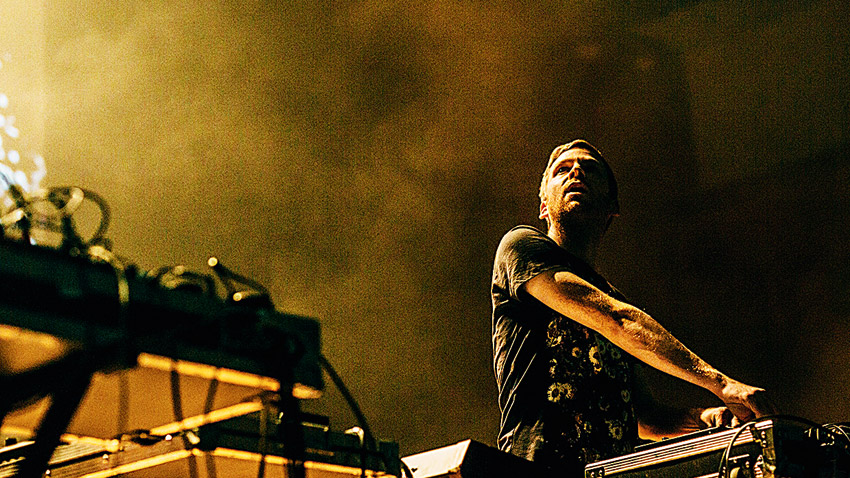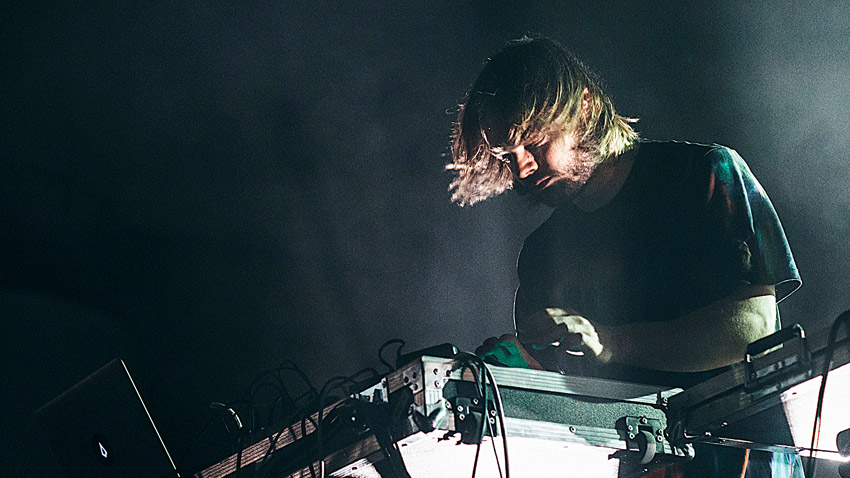Kiasmos talk tape loops and concert hall raves
Icelandic duo Ólafur Arnalds and Janus Rasmussen combine eclectic musical histories to create a unique brand of fragile yet propulsive techno

You’d be hard pushed to find a musical duo with with a more eclectic collective CV than Ólafur Arnalds and Janus Rasmussen. Arnalds is probably best known in the UK for his BAFTA-winning score work on the series Broadchurch, but long before he was soundtracking prime time TV, he began his career drumming in hardcore bands and collaborating with German death metallers Heaven Shall Burn. Between those two ends of the spectrum, the Icelandic musician has carved out a successful solo career blending modern classical and ambient influences, whist also working prolifically as a producer and studio engineer. Faroe Islands native Rasmussen, meanwhile, is a member of dark synth pop outfit Bloodgroup, alongside a long list of other musical endeavours.
The pair discovered a shared love of underground club music while Arnalds toured as Bloodgroup’s sound engineer, leading to their first experiments with electronic production as Kiasmos. With a distinctive sound that blends ambient piano and strings with punchy, minimal techno drums and live percussion, the past decade has seen Kiasmos grow from a fledgling side project to one of the most exciting prospects in live techno. With their latest EP, Blurred, out now on Erased Tapes, we caught up with the pair backstage at the label’s 10th anniversary celebrations.
Are we right in thinking the pair of you discovered a shared love of techno while on tour together?
Janus Rasmussen: “That’s right, in 2007 or 2008.”
Ólafur Arnalds: “We discovered we were both into this kind of music when we were on a very long drive somewhere. I think Janus showed me something on his iPad.”
JR: “Back then, I was really into early-2000s, minimal, dark 128bpm techno.”
ÓA: “We bonded over it as nobody else was into it around us.”
Get the MusicRadar Newsletter
Want all the hottest music and gear news, reviews, deals, features and more, direct to your inbox? Sign up here.
JR: “After that, we just started hanging out and tried to make something similar.”
How does the Kiasmos production process work? Do you have set roles or just throw ideas about between you?
JR: “Olafur plays piano, but mostly we just sit around a computer and make stuff up.”
ÓA: “Very often, Janus sits at the computer and I’ll sit at the piano. He’ll be making edits to a beat while I’m trying to figure out the melody while listening to it on loop.”
JR: “Ólafur will shout over, ‘Hey, that bit’s good’, or, ‘Keep that bit going’.”
How quickly did you manage to settle into the sort of sound you wanted to make with Kiasmos?
JR: “We had many years where we really weren’t heading anywhere, I guess. It was just for fun at first; no real seriousness to it. We were happy if we got to play in a club here and there. Then it wasn’t really until we made Thrown.”
ÓA: “Thrown was the first time we used strings in a track, and after that, pretty much every song we did used strings.”
Was there a moment when you were making that track that it just clicked?
JR: “We were really against the idea of using strings and pianos for years. That’s not really what we wanted to do with Kiasmos.”
ÓA: “That’s what we were trying to get away from!”
You’ve both done score or soundtrack work, and that cinematic feel seems to bleed into your Kiasmos tracks - are you saying you were trying to avoid that happening?
ÓA: “The reason we did Kiasmos was to get away from that, take a break and do something else. But, of course, if that’s what you do full-time, that’s probably what you’re best at.”
JR: “I guess after years of not really getting anywhere with the completely minimal sound, we were finally like, ‘OK, let’s try the strings’. And it just worked. It was like, ‘This is nice, we know how to do this!’”
From a production point of view, how much of a challenge is it to combine acoustic elements with synths and electronic beats?
ÓA: “I don’t think it’s difficult at all, actually - especially strings; they sit really nicely together with electronics.”
JR: “It’s more about what sort of piano or synth lines you’re playing.”
ÓA: “You have to write the right material. So, the strings, we just use those as pads, so it’s something that already works with those types of tracks.”
JR: “We rarely use strings percussively or staccato.”
Where do the string sounds in your tracks come from? Are you recording them or do you use sampled instruments?
ÓA: “It’s a bit of a mix, it depends on when things are being recorded. We also use a lot of my own samples, though. Those aren’t multisampled instruments, but full progressions and phrases that I’ve recorded. On the first record, there’s quite a lot of Spitfire Audio sampled strings, but only when we have these big orchestral parts - if it goes into a solo we’ll actually record that. You can’t really replicate that with samples; it’s impossible.”
All of your tracks have really punchy, crisp drum sounds. What are you using to create those?
ÓA: “A 909 [laughs].”
JR: “It’s not all that…”
ÓA: “Well, every kick at least. Almost every song has a 909 kick.”
JR: “No… I’m sure that’s not true.”
ÓA: “It is! Or at least, it’s originally a 909 kick sample that we’ve morphed and changed so often that it’s eventually turned into something completely different. But it’s that originally.”
JR: “It’s samples, basically. We treat them a lot, though. We’re not afraid of EQing and pitching things down to transform them.”
We were really against the idea of using strings and pianos for years. That’s not really what we wanted to do with Kiasmos.
What are you using to do that, is it mostly software, or are you running it through any analogue hardware?
JR: “I use Pro Tools.”
ÓA: “It’s a bit of both. Then almost all the percussion is live stuff that we record to create loops. We’ll play and then chop stuff up and rearrange it.”
JR: “Usually all the shakers on the record are us.”
ÓA: “Some snares too, and any rim shot or click stuff.”
JR: “The snare from our new single, Blurred, is actually Olafur hitting the piano. He was playing the piano and I was like, ‘We need a snare’. He didn’t want to have to go find a snare, so he was just like, ‘Try sampling this’, and whacked the piano.”
Do you consciously try to make sure there’s a blend of live and sequenced stuff in all your tracks, then?
ÓA: “Yeah, but also it’s just more fun to make it that way.”
JR: “You feel more passionate about it when you know that some of the drum sounds are actually you.”
ÓA: “It’s also good not to be sitting by a computer all the time. It makes it more intuitive, getting creative with your hands.”
What about the synth sounds on your tracks… what gets used regularly there?
ÓA: “The Juno-60 is on every song, pretty much. For pads and things like that.”
JR: “We did actually use the MS-10 for bass a lot on this latest EP. And the Korg PS3100 is on the newer stuff, too.”
Has that been the setup across all your releases?
ÓA: “The Juno and MS-10 have always been there.”
JR: “We used to use the Juno-106 as well.”
ÓA: “That was basically until I got the Juno-60!”
Where do you record mostly? Is it in one of your studios?
JR: “We’re in Ólafur’s room, mostly.”
ÓA: “We always start songs together, then sometimes I’ll go in and mix things a bit on my own, or Janus might do a bit of editing. But in terms of songwriting, it’s always us working together.”
JR: “That’s where the Kiasmos sound comes from - us working together. Our tastes rub off on one another.”

Space and spacial effects seem to be a big part of the Kiasmos sound. What are you using in that department?
ÓA: “This is definitely my department…”
JR: “Your expensive department [laughs].”
ÓA: “I work with tape delays a lot. The Roland 501 Space Echo gets used a lot. Actually, the 555, which is the rack version of the same thing. I have several of those as I always want to keep a stereo pair in my chain. Plus, there always seems to be one broken and maybe one on the road, so I need at least four! You’re lucky if you can have two and keep both working. There seems to always be at least one being serviced at any time. In fact, right now, I only have one working.
“I also have an EMT 240 plate reverb and an EMT 246 digital reverb. Those few things can used quite a lot to create the ambient textures that run through our music.”
Do you limit yourself to using just a couple of different reverbs on a track, or will you put everything in its own space?
ÓA: “They’re usually at least the same type of reverb. I don’t tend to use many plugin reverbs in our productions - there’s just one I use regularly, which is the EMT 250. I also have that as an outboard, but if you want to run lots of them at the same time with different settings, you have to use the plugin version. But on the whole, I don’t like to mix too many different reverbs in one song, I just try to find a sound that I like and go with that in order to create some ambient textures.”
Do you think your experience producing within the soundtrack and classic spheres helps you bring something unique to the electronic music realm?
ÓA: “I think so. My background in that world definitely feeds into this. Even though these are electronic songs and techno arrangements, I still try to keep things intricate and moving. I like to focus on how the elements play together, like you would with a chamber orchestra or something.”

Is it fair to say you try and add a human - or at least out-of-the-box - element to almost every part of your tracks?
ÓA: “Absolutely. There needs to be some errors in there; some mistakes.”
JR: “We usually try to keep the mistakes in.”
ÓA: “That’s where some of the best things happen. You can cut things out and use them as something unexpected. That’s part of why we love these machines, like the tape echoes: we love them because they’re not perfect. They’re wobbly and slow down occasionally, and you’ll get these slight pitch shifts. That’s what makes them alive.”
JR: “We also used a lot of tape loops on the EP, which were imperfect loops.”
ÓA: “Oh yeah. I was doing this for a score, actually, where I needed a lot of droning, ambient stuff. I got a tape machine and just glued the ends of the tape together and ran it in this very large circle around my studio and back to the tape machine. That’s how we created a lot of ambiences. A lot of the atmospheric, ambient stuff you hear in our tracks is created that way. These textures that are just there, in the mix. It’s really wonderful, because you can hear the splice in the tape, which you’re not really supposed to be able to hear - if I was born in the ’70s, maybe I’d know how to do that properly, but as it is, you can hear these splice points, and I actually really like that.”
Let’s talk about your live sets a little: what are you using to translate the music on stage?
JR: “It’s fairly simple in a way: we just try to use the gear that we have as much as possible. So my station is a laptop running Ableton, with lots of channels running the stems, drums, bass and bits of melody. Then there’s one channel named Filter, which I’m sending out to Ólafur’s Novation Bass Station, so he can filter various sounds in some songs. I’m running all of that through an RME Fireface UFX. Then I have a Kaoss Pad for making extra bits of loops and glitch stuff. I also have an Analog RYTM for extra hi-hats, kicks and snares in some songs. That’s all going through a Nexus mixer.”
ÓA: “Over at my station, I play synths, pads and some lead melodies over on the synths I have there, which are the Juno-60 and Bass Station II. I also launch the clips from my side.”
Is there much room for improvisation within the live set?
ÓA: “It’s pretty regulated, but we’ve created specific moments where we can. Basically, before we take everything into Ableton, we go into the original sessions to make the stems and edit them there, so that we have different edits of the songs for the live shows. At certain parts, we create space in order to improvise; so we might have 16 bars that we can loop to play over the top of, but then we’re ready to go into the next scene.
“Because our music is so structured with the string arrangements and things, it’s not particularly ‘loopy’. So we can't just work with loops all the time as a string arrangement will build and change constantly over two minutes. We have to actually play out that two-minute sequence; we can’t make it longer or shorter, because the strings are coming from the playback. In those moments, it’s very heavily boxed in, but away from where that kind of thing is happening, we can improvise a little.”
Compared to previous projects, do you find it’s harder to connect with the audience when you’re behind a laptop or a pile of electronics?
ÓA: “Not really. Obviously, as I’m sure you know, we’re actually playing things up there, even though we might just be pressing buttons or launching loops. It’s still a performance. But it is something we’re aware of, and that’s why we rely quite heavily on the visual aspect of the show, using laser and projections.”
JR: “We always tour with a light designer”
ÓA: “We make sure we have a strong visual look to our shows, which is always there. So when you come see our shows, it’s always going to have that same style.”
Blurred is available now on Erased Tapes. For more news and live dates from Kiasmos visit their website.


Future Music is the number one magazine for today's producers. Packed with technique and technology we'll help you make great new music. All-access artist interviews, in-depth gear reviews, essential production tutorials and much more. Every marvellous monthly edition features reliable reviews of the latest and greatest hardware and software technology and techniques, unparalleled advice, in-depth interviews, sensational free samples and so much more to improve the experience and outcome of your music-making.





![PRS Archon Classic and Mark Tremonti MT 15 v2: the newly redesigned tube amps offer a host of new features and tones, with the Alter Bridge guitarist's new lunchbox head [right] featuring the Overdrive channel from his MT 100 head, and there's a half-power switch, too.](https://cdn.mos.cms.futurecdn.net/FD37q5pRLCQDhCpT8y94Zi.jpg)




